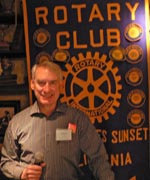Einstein for Everyone! — Robert Piccione

Dr Piccioni has a BS in Physics from Caltech and a PhD in High Energy Physics from Stanford University. He was a faculty member at Harvard University and did research at the Stanford Linear Accelerator in Palo Alto. (His father, Dr Oreste Piccioni, was a prominent high energy physicist.)
Dr Piccioni has introduced cutting-edge science to many non-scientific audiences, including service clubs, civic groups, school children, and a National Geographic/Lindblad cruise, making the wonders of our universe accessible to everyone. He has given invited talks at Harvard, Caltech, UCLA, and Stanford University, and is presently giving an 8-week course on Einstein’s theories at the Osher Institute (an adult education program) at California State University Channel Islands and UCLA. His published books include Everyone’s Guide to Atoms, Einstein & the Universe; Can Life Be Merely an Accident? and A World Without Einstein.
Everyone can appreciate music, even if not a musician. The same applies to math, if presented in terms that people can understand. Albert Einstein (1879-1955) was a German-born theoretical physicist who had a slow unpromising start to life. He was slow to talk, and was expelled from the 2nd grade for inattention. He dropped out of high school, but finally got into college on his 2nd attempt. He was the only one of his classmates who couldn’t find a job, so he was supported by relatives. He applied for a job in the Swiss Patent Office, was labeled unqualified after his initial interview, but was later hired anyway thanks to political influence from some friends. In spite of repeated failure, he was persistent and refused to quit. He worked with only paper and pen, never doing any experiment or measurements, but he spent a large amount of time thinking about how the known principles of physics were related.
In 1905, Einstein published 5 revolutionary papers on all major open issues in physics, and in 1907 he got a job as a high school physics teacher. He dealt with problems in statistical mechanics, quantum theory, particle theory, the motion of molecules, and the thermal properties and photon theory of light. He used these ideas to model the structure of the entire universe. One of his papers qualified him for a PhD. In 1913, the prominent German physicist Max Planck stated that there was hardly a major problem in physics to which Einstein had not made a major contribution, and by 1914 he had gotten a university appointment.
Einstein realized that Newtonian mechanics was inadequate to reconcile with the laws of electromagnetic fields, leading to his Special Theory of Relativity. He soon extended this principle to gravitational fields, and in 1916 published his General Theory of Relativity. He was awarded the Nobel Prize in Physics in 1921 for his many contributions.
He provided a definitive proof of the existence of atoms, ending a 2500 year debate. His theory on the photoelectric effect has led to modern technology including solar cells, CCDs for cameras, lasers, DVDs, barcode scanners and telecommunication technology. His Theory of Relativity is used by GPS systems for accurate spatial localization on the surface of the earth. Microelectronics, computers and cell phones benefit from his work. His famous mass-energy equivalence formula E=mc² is the basis for nuclear power and smarter energy (“c” is the speed of light). He showed that mass and energy are different forms of the same thing, and his formula is analogous to using a known currency exchange rate to convert between the values of different currencies.
Dr Piccioni reviewed the enormous amount of energy contained in physical mass. For example, annual US energy use is equal to one ton of mass, which contains energy equivalent to 25 trillion kWh, or 5 billion tons of coal, or 2 billion tons of gasoline, or 133 tons of hydrogen, the latter form producing no pollution from combustion. He discussed the generation of nuclear energy. Energy can come from either making big atomic nuclei smaller (nuclear fission, which is radioactive), or by making small atomic nuclei bigger (nuclear fusion, which is not radioactive). This would be 40 million times more efficient than coal, with no pollution. Nuclear fusion has been under study for decades because of its enormous potential if achievable. A private company in Chicago states that it has found a non--fusion technique for producing nuclear energy that could possibly become a commercial process in 5 years.
Dr Piccioni reviewed his published books (listed above), of which he had samples for purchase after the meeting. His website is:
http://www.guidetothecosmos.com/.